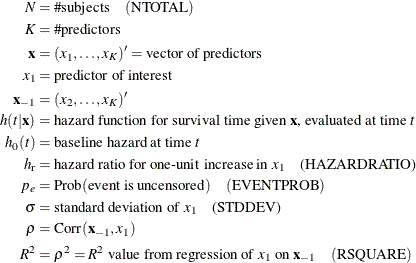The POWER Procedure
- Overview
-
Getting Started

-
Syntax
 PROC POWER StatementCOXREG StatementLOGISTIC StatementMULTREG StatementONECORR StatementONESAMPLEFREQ StatementONESAMPLEMEANS StatementONEWAYANOVA StatementPAIREDFREQ StatementPAIREDMEANS StatementPLOT StatementTWOSAMPLEFREQ StatementTWOSAMPLEMEANS StatementTWOSAMPLESURVIVAL StatementTWOSAMPLEWILCOXON Statement
PROC POWER StatementCOXREG StatementLOGISTIC StatementMULTREG StatementONECORR StatementONESAMPLEFREQ StatementONESAMPLEMEANS StatementONEWAYANOVA StatementPAIREDFREQ StatementPAIREDMEANS StatementPLOT StatementTWOSAMPLEFREQ StatementTWOSAMPLEMEANS StatementTWOSAMPLESURVIVAL StatementTWOSAMPLEWILCOXON Statement -
Details

-
Examples
 One-Way ANOVAThe Sawtooth Power Function in Proportion AnalysesSimple AB/BA Crossover DesignsNoninferiority Test with Lognormal DataMultiple Regression and CorrelationComparing Two Survival CurvesConfidence Interval PrecisionCustomizing PlotsBinary Logistic Regression with Independent PredictorsWilcoxon-Mann-Whitney Test
One-Way ANOVAThe Sawtooth Power Function in Proportion AnalysesSimple AB/BA Crossover DesignsNoninferiority Test with Lognormal DataMultiple Regression and CorrelationComparing Two Survival CurvesConfidence Interval PrecisionCustomizing PlotsBinary Logistic Regression with Independent PredictorsWilcoxon-Mann-Whitney Test - References
Analyses in the COXREG Statement
Score Test of a Single Scalar Predictor in Cox Proportional Hazards Regression (TEST=SCORE)
The power-computing formula is based on Hsieh and Lavori (2000, equation (2) and the section "Variance Inflation Factor" on page 556).
Define the following notation for a Cox proportional hazards regression analysis:

The Cox proportional hazards regression model is

You can convert a regression coefficient to a hazard ratio by using the equation  .
.
The hypothesis test of the first predictor variable is

The upper and lower one-sided cases are expressed differently than in other analyses. This is because  corresponds to a negative correlation between the tested predictor and survival and thus, by the convention used in PROC
POWER for regression analyses, the lower side.
corresponds to a negative correlation between the tested predictor and survival and thus, by the convention used in PROC
POWER for regression analyses, the lower side.
The approximate power is
![\[ \mr{power} = \left\{ \begin{array}{ll} \Phi \left( z_\alpha - \sigma \sqrt {N p_ e (1 - R^2)} \log (h_\mr {r}) \right), & \mbox{upper one-sided} \\ 1 - \Phi \left( z_{1-\alpha } - \sigma \sqrt {N p_ e (1 - R^2)} \log (h_\mr {r}) \right), & \mbox{lower one-sided} \\ \Phi \left( z_\frac {\alpha }{2} - \sigma \sqrt {N p_ e (1 - R^2)} \log (h_\mr {r}) \right) + 1 - \Phi \left( z_{1-\frac{\alpha }{2}} - \sigma \sqrt {N p_ e (1 - R^2)} \log (h_\mr {r}) \right), & \mbox{two-sided} \\ \end{array} \right. \\ \]](images/statug_power0091.png)
For the one-sided cases, a closed-form inversion of the power equation yields an approximate total sample size
![\[ N = \left( \frac{\left( z_{\mr{power}} + z_{1-\alpha } \right)^2}{p_ e (1-R^2) \sigma ^2 \log (h_\mr {r})} \right) \]](images/statug_power0092.png)
For the two-sided case, the solution for N is obtained by numerically inverting the power equation.